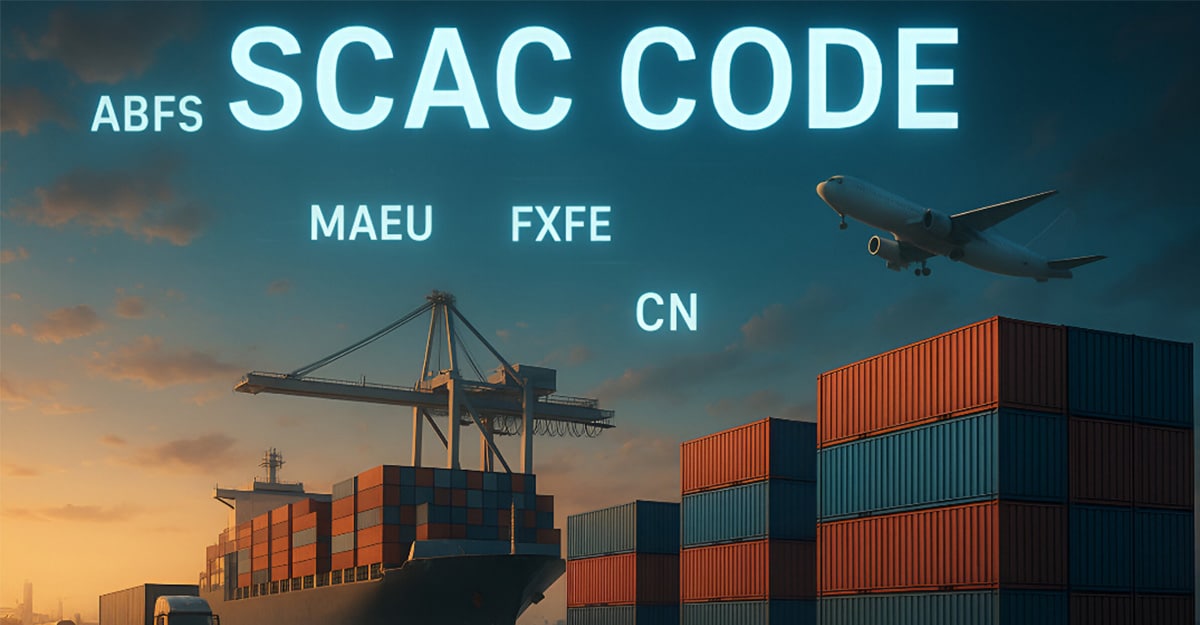If you’re involved in shipping, logistics, or supply chain management, you may have come across the term SCAC code. While it might sound technical, this code plays a crucial role in the smooth movement of freight across the United States and internationally. In this guide, we’ll break down everything you need to know about SCAC codes—what they are, why they matter, who needs them, and how to obtain one.
Understanding the Basics: What Is a SCAC Code?
SCAC stands for Standard Carrier Alpha Code. It’s a unique two-to-four-letter code used to identify transportation companies. Developed and maintained by the National Motor Freight Traffic Association (NMFTA), the SCAC system helps standardize and simplify communications in the shipping industry.
Think of the SCAC code as a “short name” or unique identifier for a carrier. For example:
- UP = Union Pacific Railroad
- CN = Canadian National Railway
- MAEU = Maersk Shipping Line
- FXFE = FedEx Freight East
Each carrier has a unique SCAC, so when it appears on shipping documents, electronic data interchanges (EDI), or customs filings, everyone involved knows exactly which company it refers to.
Why Was the SCAC Code Introduced?
Before SCAC codes existed, shipping documentation was often long, inconsistent, and prone to confusion. Different carriers could have similar names, which made data exchange and record-keeping complicated.
To solve this, the NMFTA introduced SCAC codes in the 1960s. The goal was to:
- Standardize carrier identification across the industry.
- Simplify documentation such as bills of lading, freight invoices, and EDI transactions.
- Reduce errors and delays caused by duplicate or confusing carrier names.
- Support U.S. Customs requirements, particularly as trade volumes grew.
Today, SCAC codes are widely used not only by shippers and carriers but also by government agencies and global supply chain partners.
Who Needs a SCAC Code?
Not every company in the logistics chain needs a SCAC code, but many do. Here’s a breakdown:
1. Carriers
Any trucking company, rail line, ocean carrier, or air freight company operating in the U.S. typically needs a SCAC code. Without it, they cannot properly interact with shippers, freight brokers, or customs.
2. Freight Forwarders and Brokers
Freight forwarders who handle goods movement may also require a SCAC code, especially if they work with U.S. Customs and Border Protection (CBP) or handle import/export shipments.
3. Customs Filers
For companies filing through the Automated Commercial Environment (ACE) or submitting customs declarations, SCAC codes are required to identify carriers.
4. Businesses Working With the U.S. Government
If you want to haul freight for U.S. government agencies—such as the Department of Defense—you must have a registered SCAC code.
Where Are SCAC Codes Used?
SCAC codes show up in many parts of shipping and logistics, including:
- Bills of Lading (BOLs) – to identify the carrier responsible for the freight.
- Freight Bills and Invoices – for accurate billing.
- EDI Transactions – where electronic data requires a standardized code.
- Customs and Import/Export Documents – especially filings with CBP.
- Freight Tracking Systems – to connect shipments with carriers.
- Government Contracts – as part of mandatory compliance.
Without SCAC codes, these processes would be prone to error, potentially causing costly shipping delays.
How to Get a SCAC Code
If your company needs an SCAC code, you can obtain one from the National Motor Freight Traffic Association (NMFTA). Here’s the process:
- Apply Through the NMFTA Website
- Visit the official NMFTA site and fill out an application for a SCAC assignment.
- Provide Company Details
- You’ll need to submit business information, including your company name, address, and type of carrier service you provide (truck, rail, ocean, or air).
- You’ll need to submit business information, including your company name, address, and type of carrier service you provide (truck, rail, ocean, or air).
- Pay the Application Fee
- As of recent updates, the cost for a new SCAC code is around $95 USD (may vary depending on membership or application type).
- As of recent updates, the cost for a new SCAC code is around $95 USD (may vary depending on membership or application type).
- Receive Your SCAC Code
- Once approved, you’ll receive your unique two-to-four-letter code.
- Once approved, you’ll receive your unique two-to-four-letter code.
- Renew Annually
SCAC codes must be renewed each year, as they are tied to NMFTA’s active directory of carriers.
Types of SCAC Codes
SCAC codes aren’t just random; they can indicate the type of carrier:
- Codes ending in “X” → trucking companies (e.g., ABFS for ABF Freight System).
- Codes ending in “U” → container owners (e.g., MAEU for Maersk).
- Codes ending in “Z” → brokers (non-asset-based logistics providers).
- Codes ending in “K” → private rail cars.
This structure helps quickly identify what kind of business the code belongs to.
Difference Between SCAC Code and Other Codes
It’s common to confuse SCAC codes with other shipping identifiers, so let’s clear that up:
- MC Number (Motor Carrier Number): Issued by the FMCSA to trucking companies. It authorizes them to operate.
- DOT Number: Identifies carriers for safety compliance with the U.S. Department of Transportation.
- IATA Code: A 2–3 digit code for airlines (international air travel).
- UN/LOCODE: Identifies specific locations like ports and cities.
- SCAC Code: Specifically identifies carriers in freight and logistics.
Each serves a unique purpose, but the SCAC code is critical for documentation and customs processes.
Why SCAC Codes Are Important
For businesses and carriers alike, SCAC codes are more than just letters. They:
- Ensure Compliance – Required for customs filings, government freight, and EDI.
- Save Time and Reduce Errors – Standardized codes prevent confusion.
- Enable Automation – Freight systems and software rely on SCAC codes to process data.
- Build Credibility – Having a registered SCAC code shows you are a legitimate, recognized carrier.
Without an SCAC code, a trucking company may not be able to partner with freight brokers, bid on government contracts, or move international shipments.
How to Look Up a SCAC Code
If you’re trying to find a carrier’s SCAC code:
- NMFTA Directory – The official source, though access requires a subscription.
- Bills of Lading or Freight Invoices – SCAC codes are usually listed there.
- Industry Databases – Some logistics platforms provide lookups for free.
Common Questions About SCAC Codes
1. Do all trucking companies need a SCAC code?
Not all, but most carriers working with customs, brokers, or government shipments must have one. Smaller local-only carriers may not need it.
2. How long does it take to get an SCAC code?
Processing is usually fast—often within 24 to 48 hours once your application is complete.
3. Can two companies have the same SCAC code?
No. Each SCAC code is unique to a single carrier.
4. Is a SCAC code only for U.S. companies?
Mostly yes—it’s a U.S.-based system, but international carriers working with U.S. imports/exports must also have SCAC codes.
Conclusion
A SCAC code (Standard Carrier Alpha Code) may be just a few letters, but it carries big importance in the world of shipping and logistics. It simplifies communication, ensures compliance with customs and government agencies, and keeps the global supply chain running smoothly.
For carriers and freight forwarders, having a valid SCAC code is not just recommended—it’s often required. For shippers and businesses, knowing how to use and recognize SCAC codes helps ensure accuracy in every shipment.
So whether you’re a trucking company, freight forwarder, or shipper, understanding and using SCAC codes is a key step in making your logistics operations more efficient, compliant, and professional.
Get a Free Quote Today! Compare Express vs Economy

I’m Tammy Waller, a supply chain and logistics specialist with over 10 years of expertise. I’ve been an author and SFL employee for over 10 years.
As an author, I’ve been able to teach others. I love guiding users through supply chain and logistics operations.
I have substantial experience managing logistics operations, supply chain management, transportation, inventory management, and warehousing in shipping-moving and logistic services. I’ve worked on many worldwide logistics and supply chain projects, honing my abilities in negotiating rates, scheduling shipments, and managing vendors.



